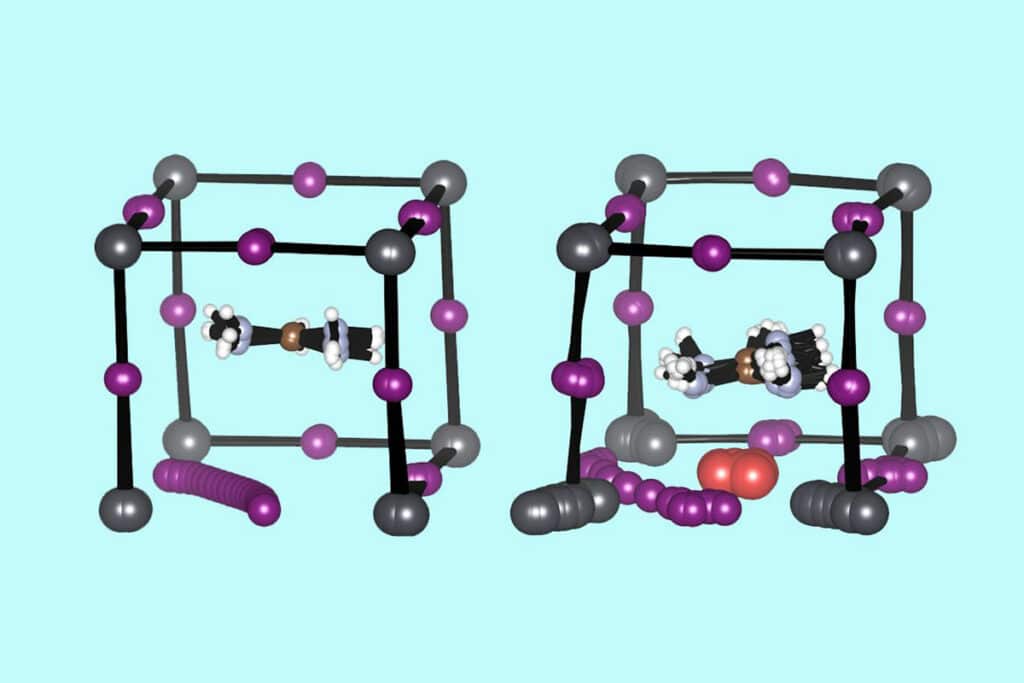Solar cells, the devices capable of turning solar light into electricity, could solve many of today’s energy supply problems. However, there are many obstacles that prevent massive use, such as a relatively high cost and the low efficiency of silicon-based solar cells.
In theory, perovskite-based solar cells could be made with raw materials that cost less and are more readily available than silicon. They also could be produced using less energy and a simpler manufacturing process. But so far, a stumbling block has been that perovskite breaks down with exposure to light and heat.
Now, an international team led by UCLA researchers has developed a way to use perovskite in solar cells while protecting it from the conditions that cause it to deteriorate. Researchers added small quantities of ions – electrically charged atoms – of a metal called neodymium directly to perovskite. This resulted in an enhanced halide perovskite that was much more durable when exposed to light and heat and also converted light to electricity more efficiently.
The ability of halide perovskite to convert light to electricity is due to the way its molecules form a repeating grid of cubes. The structure is held together by bonds between ions with opposite charges. However, exposure to light and heat causes negatively charged ions to pop out of the perovskite. This damages the crystal structure and diminishes the material’s energy-converting properties. Neodymium’s ions are just the right size to nestle within a cubic perovskite crystal, and they carry three positive charges, which the scientists hypothesized would help hold negatively charged ions in place.

For every 10,000 molecules of perovskite, researchers added about eight neodymium ions and then tested the material’s performance in solar cells. Operating at maximum power and exposed to continuous light for more than 1,000 hours, the device using solar cells using enhanced perovskite retained about 93% of its efficiency in converting light into electricity. On the other hand, a solar cell using standard perovskite lost half of its power conversion efficiency after 300 hours under the same conditions.
Shining continuous light on solar cells without any equipment drawing power accelerates the degradation of perovskite. A device using perovskite with neodymium retained 84% of its power conversion efficiency after more than 2,000 hours. In contrast, a device with standard perovskite retained none of its efficiency after that amount of time.
The researchers also tested the material’s ability to withstand high temperatures by heating solar cells with both materials to about 180 degrees Fahrenheit (82 degrees Celsius). They found the solar cell with augmented perovskite held onto about 86% of its efficiency after more than 2,000 hours, while a standard perovskite device completely lost its ability to convert light to electricity during that time.
“The ions tend to move through the perovskite like cars on the highway, and that causes the material to break down,” said lead author Yepin Zhao, a postdoctoral researcher in Yang’s lab. “With neodymium, we identified a roadblock to slow down the traffic and protect the material.”
Researchers say the advance could help perovskite solar cells reach the market within the next two to three years.
Journal reference:
- Yepin Zhao, Ilhan Yavuz, Minhuan Wang, Marc H. Weber, Mingjie Xu, Joo-Hong Lee, Shaun Tan, Tianyi Huang, Dong Meng, Rui Wang, Jingjing Xue, Sung-Joon Lee, Sang-Hoon Bae, Anni Zhang, Seung-Gu Choi, Yanfeng Yin, Jin Liu, Tae-Hee Han, Yantao Shi, Hongru Ma, Wenxin Yang, Qiyu Xing, Yifan Zhou, Pengju Shi, Sisi Wang, Elizabeth Zhang, Jiming Bian, Xiaoqing Pan, Nam-Gyu Park, Jin-Wook Lee and Yang Yang. Suppressing ion migration in metal halide perovskite via interstitial doping with a trace amount of multivalent cations. Nature Materials, 2022; DOI: 10.1038/s41563-022-01390-3
New research could lead to more durable perovskite-based solar cell
Source: Tambay News

0 Comments